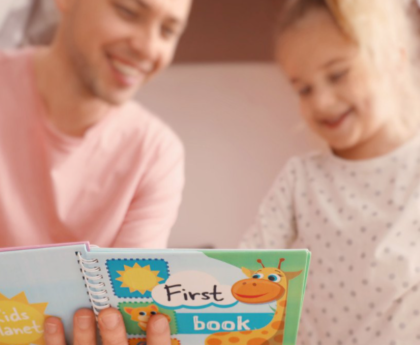Reading books out loud to your child is a precious and important part of their development. Read-alouds support children’s literacy development, bonding experiences, and story comprehension skills.
However, simply reading the words on the page isn’t always enough to facilitate meaningful reading experiences with your kids. Making storytime an interactive and educational bonding memory can profoundly impact your child’s curiosity and interest in reading.
To help you bring stories to life and encourage a love of reading in your children, consider a few of these read-aloud tips for parents.
Should All Parents Read Aloud With Their Kids?
If you can read, it’s a great idea to start reading aloud to your child when they’re young. As they begin to learn how to read, continue to read aloud with them to strengthen their literacy development.
There are many reasons why parents and adults benefit children when reading aloud to them:
- Expose your child to a rich vocabulary
- Introduce your child to language structures they may not encounter in everyday conversation
- Help your child’s mind absorb new words, sentence patterns, and concepts
- Set a foundation for strong language development and comprehension skills
- Foster a love for reading from an early age
- Instill social-emotional learning skills
- Nurture an emotional bond between you and your child
When children experience storytime as an enjoyable, engaging experience, they develop positive associations with books. They’re also more likely to embrace reading as a lifelong habit.
Tips for Getting Your Child Excited to Read
Preparing you and your child’s reading time can help set the stage for an engaging read-aloud experience. This is especially important if your child is physically active, doesn’t like sitting still, or typically resists interacting with books.
Choose the Right Type of Books
Start by choosing age-appropriate books that align with your child’s interests and developmental stage. That way, you know they can comprehend and relate to the story—which encourages their attention and enthusiasm.
Get Comfortable
Next, create a cozy and distraction-free reading space for you and your child. Whether it’s a quiet corner of the living room, your child’s bed before sleep, or a designated reading nook, staying consistent with a routine and space for storytime can help your child know that it’s a special activity.
Encourage Imagination
Build interest and curiosity by encouraging your child to be imaginative before reading aloud to them. Discuss the book’s cover and title. Ask your child what they think the story might be about based on the illustrations or title. This simple action gets kids invested in the story and makes them feel like they’re part of the process before you even begin reading.
How to Make Read-Alouds More Interactive
Young children are drawn to enthusiasm and play! Therefore, it’s helpful if you make read-alouds fun and interactive for them. While you don’t need to be the most peppy voice actor for this, there are a few simple ways to step up your read-aloud techniques.
Be Expressive
One way you can make read-alouds more interactive is by using some facial expressions and voice variety. Varying your tone, pitch, and volume can capture your child’s attention and help them differentiate between characters or convey emotions. For example, you might use a soft, gentle voice for a timid character or a deep, gruff voice for a villain.
Welcome Questions
As you read, pause frequently to ask open-ended questions that encourage your child to think critically about the story, such as: “Why do you think the character did that?” or “What do you think will happen next?” These questions promote critical thinking and story comprehension and allow you to discern whether or not your child understands.
Talk With Your Child
Invite your child to participate in the read-aloud. Have them make predictions about what might happen, where the character came from, or who might appear on the next page. Let them turn the pages of the book or point to illustrations. This level of engagement helps solidify their connection to the story and reinforces their role as an active listener.
Summarize and Repurpose the Story
You can extend story time beyond the book itself. After reading, encourage your child to retell or summarize the story in their own words, using the vocabulary and story elements they’ve just heard.
You can also take inspiration from the book and do some creative activities with your child, such as crafts, art projects, or acting out scenes from the story. These hands-on activities reinforce the concepts and make the story even more memorable for your little one.
Fun Ideas to Change Up Your Read-Aloud Routine
Whether you’re an excellent storyteller or you don’t love reading at all, consider taking a different approach to read-alouds when things feel stale. Here are some ideas:
- Change locations: Read together at the park, in a blanket fort, or somewhere new and exciting
- Invite guests: Other readers like family members or stuffed animals can make storytime more interesting
- Adventure: Go on imaginary “story adventures” by acting out scenes in the book before or after reading
- Snack time story: Let your child enjoy a snack while you read aloud, particularly if that snack is related to the story in some way
- Dress up: Let your child dress up as their favorite story character (for example, superhero, dancer, mermaid, fireman, etc.)
- Sound effects: Replace some words with silly sound effects or motions
- Listen Together: Find a video, podcast, or library event where someone else is reading aloud and attentively listen with your child
Additionally, consider turning to technology for your read-aloud moments when your child needs something different. An engaging reading app such as Reading.com helps you engage with your child as you explore early literacy skills. This offers several interactive features and multimedia elements that can captivate your child’s attention and make the experience even more immersive.
More Ways to Encourage Your Child’s Interest in Reading
Reading aloud to your child is not only a cherished bonding experience but also a powerful tool for fostering their literacy development. By implementing more interactive read-aloud techniques, you can transform storytime into a special experience that will benefit your child for years to come.
For more tips on how to foster your child’s joy in interactive storytime, explore the Reading.com platform today.





